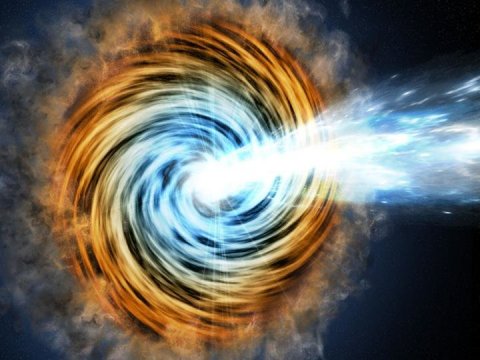[ad_1]
The VERITAS array has confirmed the detection of gamma rays from the vicinity of a supermassive black hole. While these detections are relatively common for VERITAS, this black hole is potentially the first known astrophysical source of high-energy cosmic neutrinos, a type of ghostly subatomic particle.
On September 22, 2017 the IceCube Neutrino Observatory, a cubic-kilometer neutrino telescope located at the South Pole, detected a high-energy neutrino of potential astrophysical origin. However, the observation of a single neutrino by itself is not enough for IceCube to claim the detection of a source. For that, scientists needed more information.
Very quickly after the detection by IceCube was announced, telescopes around the world including VERITAS (which stands for the “Very Energetic Radiation Imaging Telescope Array System”) swung into action to identify the source. The VERITAS, MAGIC and H.E.S.S. gamma-ray observatories all looked at the neutrino position. In addition, two gamma-ray observatories that monitor much of the sky at lower and higher energies also provided coverage.
These follow-up observations of the rough IceCube neutrino position suggest that the source of the neutrino is a blazar, which is a supermassive black hole with powerful outflowing jets that can change dramatically in brightness over time. This blazar, known as TXS 0506+056, is located at the center of a galaxy about 4 billion light years from Earth.
Initially, NASA’s Fermi Gamma-ray Space Telescope observed that TXS 0506+056 was several times brighter than usually seen in its all-sky monitoring. Eventually, the MAGIC observatory made a detection of much higher-energy gamma rays about two weeks after the neutrino detection, while VERITAS, H.E.S.S. and HAWC did not see the blazar in any of their observations during the two weeks following the alert.
Given the importance of higher-energy gamma-ray detections in identifying the possible source of the neutrino, VERITAS continued to observe TXS 0506+056 over the following months, through February 2018, and revealed the source but at a dimmer state than what was detected by MAGIC.
“The VERITAS detection shows us that the gamma-ray brightness of the source changes, which is a signature of a blazar,” said Wystan Benbow of the Smithsonian Astrophysical Observatory (SAO) that operates and manages VERITAS, and the Principal Investigator of VERITAS operations. “Finding a link between an astrophysical source and a neutrino event could open yet another window of exploration to the extreme Universe.”
The detection of gamma rays coincident with neutrinos is tantalizing, since both particles must be produced in the generation of cosmic rays. Since they were first detected over one hundred years ago, cosmic rays — highly energetic particles that continuously rain down on Earth from space — have posed an enduring mystery. What creates and launches these particles across such vast distances? Where do they come from?
“The potential connection between the neutrino event and TXS 0506+056 would shed new light on the acceleration mechanisms that take place at the core of these galaxies, and provide clues on the century-old question of the origin of cosmic rays,” said co-author and spokesperson of VERITAS Reshmi Mukherjee of Barnard College, Columbia University in New York, New York.
“Astrophysics is entering an exciting new era of multi-messenger observations, in which celestial sources are being studied through the detection of the electromagnetic radiation they emit across the spectrum, from radio waves to high-energy gamma rays, in combination with non-electromagnetic means, such as gravitational waves and high-energy neutrinos,” said co-author Marcos Santander of the University of Alabama in Tuscaloosa.
[ad_2]















